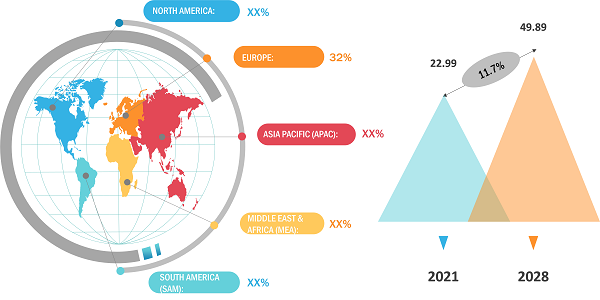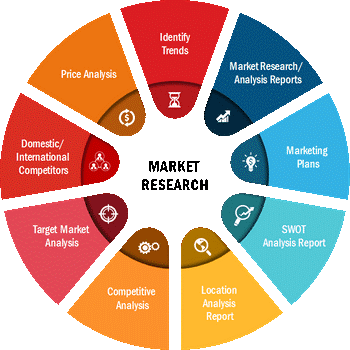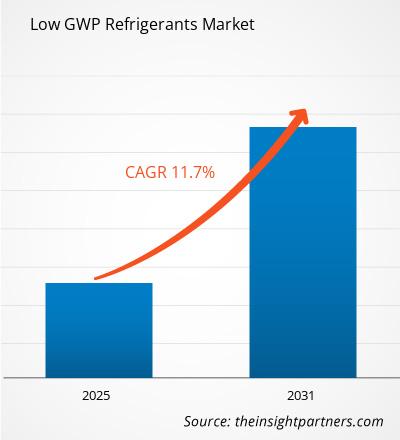Le marché des réfrigérants à faible PRG devrait passer de 22,99 milliards de dollars américains en 2021 à 2021 dollars américains. 49,89 milliards d'ici 2031 avec un TCAC de 11,7 % entre 2022 et 2031.
Les réfrigérants à faible PRG proposent diverses offres de produits dans différentes catégories ainsi que pour différentes applications. La prise de conscience accrue concernant les impacts nocifs des réfrigérants conventionnels a conduit à une forte demande pour le marché des réfrigérants à faible PRG. Les nouvelles offres de produits telles que les réfrigérants synthétiques à faible PRG sont très demandées car elles sont rentables. Cependant, la demande de réfrigérants naturels augmente car ils n'ont pas d'effets environnementaux négatifs à long terme. Cependant, les problèmes associés aux réfrigérants à faible PRG, tels que les demandes de haute pression, les risques potentiels l'inflammabilité et la toxicité devraient freiner la croissance du marché en raison de considérations de sécurité importantes.
DYNAMIQUE DU MARCHÉ
Major les applications des réfrigérants à faible PRG incluent les pompes à chaleur, la la climatisation , et la réfrigération. Les grandes pompes à chaleur industrielles et commerciales sont utilisées pour alimenter en énergie les réseaux de chaleur urbains ou locaux. Ces pompes à chaleur utilisent majoritairement des réfrigérants à base d'ammoniac de la catégorie naturelle ; cependant, l’utilisation de mélanges de HFO synthétiques à faible PRG gagne de l’importance. Les réfrigérants naturels à faible PRG les plus utilisés dans les applications de climatisation sont les hydrocarbures (pour les petites applications résidentielles) et l'ammoniac (pour les grandes applications de climatisation centrale). De plus, le CO2 est de plus en plus utilisé dans les supermarchés à des fins de climatisation et de réfrigération.
ÉTENDUE DU MARCHÉ
Les « réfrigérants mondiaux à faible PRG L'analyse du marché jusqu'en 2031" est une étude spécialisée et approfondie de l'industrie des réfrigérants à faible PRG, avec un accent particulier sur l'analyse des tendances du marché mondial. Le rapport vise à fournir un aperçu du marché avec une segmentation détaillée du marché par catégorie et application. Le marché mondial des réfrigérants à faible PRG devrait connaître une forte croissance au cours de la période de prévision. Le rapport fournit des statistiques clés sur l'état du marché des principaux acteurs du marché et présente les principales tendances et opportunités sur le marché des réfrigérants à faible PRG.
SEGMENTATION DU MARCHÉ
Le marché mondial des réfrigérants à faible PRG est segmenté en fonction de la catégorie et de l’application. En fonction de la catégorie, le marché est segmenté en naturel et synthétique. En termes d'application, le marché est classé en pompes à chaleur, climatisation, réfrigération et autres.
Aperçus stratégiques
Le rapport fournit un aperçu détaillé de la l’industrie, y compris des informations qualitatives et quantitatives. Il fournit un aperçu et des prévisions du marché mondial des réfrigérants à faible PRG en fonction de divers segments. Il fournit également la taille du marché et des estimations prévisionnelles de 2021 à 2031 pour cinq grandes régions : Amérique du Nord, Europe, Asie-Pacifique (APAC), Moyen-Orient et Amérique du Nord. Afrique (MEA) et Amérique du Sud. Le marché des réfrigérants à faible PRG de chaque région est ensuite sous-segmenté en pays et segments respectifs. Le rapport couvre l'analyse et les prévisions de 18 pays dans le monde, ainsi que les tendances et opportunités actuelles qui prévalent sur le marché.
D'un point de vue régional, l'Europe a dominé le marché des réfrigérants à faible PRG avec environ 32 % de part de marché en 2021. Cette domination peut être attribuée à la présence d'un grand nombre de fabricants de réfrigérants à faible PRG. Les principaux fabricants de réfrigérants à faible PRG dans la région comprennent le groupe Danfoss, Honeywell International Inc., The Chemours Company et Arkema Inc. Ces fournisseurs connaissent une demande constante de la part des fabricants de systèmes de climatisation et de réfrigération.

Le rapport analyse les facteurs affectant le marché des réfrigérants à faible PRG du côté de la demande et de l'offre et évalue plus en détail la dynamique du marché, c'est-à-dire, les facteurs déterminants, les contraintes, les opportunités et les tendances futures. Le rapport fournit également une analyse exhaustive des cinq forces de Porter mettant en évidence les facteurs affectant le marché des réfrigérants à faible PRG.
IMPACT DE LA PANDÉMIE DE COVID-19
L'épidémie de COVID-19 a eu un impact négatif sur la demande mondiale de réfrigérants, ce qui a reflété une baisse significative des volumes de commandes parmi les fabricants, entraînant une baisse du volume de production. La baisse des volumes de production a eu un impact négatif sur les activités de divers fabricants industriels, notamment les fabricants de réfrigérants à faible PRG. Ainsi, l’achat de réfrigérants à faible PRG a diminué au cours de la phase initiale de propagation du COVID-19, ce qui a eu un impact négatif sur la croissance du marché mondial des réfrigérants à faible PRG.
La baisse importante de la demande a été observée dans le secteur commercial de l'industrie chimique. Cela est dû à la fermeture drastique des lieux publics en Amérique du Nord, en Europe, en Asie-Pacifique, au Sud et au Sud. Amérique centrale et Moyen-Orient & Afrique. Cependant, depuis 2021, les lieux publics ont commencé à rouvrir et la tendance à la croissance devrait se poursuivre. Cela stimulerait l'achat de réfrigérants à faible PRG, renforçant ainsi la croissance du marché.
ACTEURS DU MARCHÉ
Le rapport couvre les développements clés du réfrigérants à faible PRG stratégies de croissance organique et inorganique du marché. Diverses entreprises se concentrent sur des stratégies de croissance organique, telles que les lancements de produits, les approbations de produits, les brevets et les événements. Les stratégies de croissance inorganique sur le marché sont les acquisitions, les partenariats et les collaborations. Ces activités ont ouvert la voie à l’expansion des activités et à la clientèle des acteurs du marché. Les acteurs du marché des réfrigérants à faible PRG devraient avoir des opportunités de croissance lucratives à l’avenir avec la demande croissante de réfrigérants à faible PRG. Vous trouverez ci-dessous une liste de quelques entreprises engagées sur le marché des réfrigérants à faible PRG.
Le rapport comprend également les profils des principales entreprises du marché des réfrigérants à faible GWP ainsi que leur analyse SWOT et leurs stratégies de marché. En outre, le rapport se concentre sur les principaux acteurs du secteur avec des informations telles que les profils d'entreprise, les composants et services proposés, les informations financières des trois dernières années et les développements clés au cours des cinq dernières années.
- •Honeywell International Inc.•Arkema Inc.• Dongyue Group Co. Ltd.•Daikin America Inc.•Shandong Yuean Chemical Industry Co. LTD.•The Chemours Company•Zhejiang Sanmei Chemical Incorporated Company •Le groupe Danfoss•Zhejiang Quzhou Lianzhou Refrigerants Co., Ltd.•Trust & Holdings, Inc.
L'équipe de recherche et d'analyse dédiée d'Insight Partner est composée de professionnels expérimentés possédant une expertise statistique avancée et propose diverses options de personnalisation dans l'étude existante.

- Analyse historique (2 ans), année de base, prévision (7 ans) avec TCAC
- Analyse PEST et SWO
- Taille du marché Valeur / Volume - Mondial, Régional, Pays
- Industrie et paysage concurrentiel
- Ensemble de données Excel


- Joint Pain Injection Market
- Biopharmaceutical Tubing Market
- Predictive Maintenance Market
- Medical Enzyme Technology Market
- Europe Tortilla Market
- Glycomics Market
- Parking Management Market
- Compounding Pharmacies Market
- Non-Emergency Medical Transportation Market
- Artificial Intelligence in Healthcare Diagnosis Market

Report Coverage
Revenue forecast, Company Analysis, Industry landscape, Growth factors, and Trends

Segment Covered
This text is related
to segments covered.

Regional Scope
North America, Europe, Asia Pacific, Middle East & Africa, South & Central America

Country Scope
This text is related
to country scope.
Trends and growth analysis reports related to Chemicals and Materials : READ MORE..
The List of compaies
- Honeywell International Inc.
- Arkema Inc.
- Dongyue Group Co. Ltd.
- Daikin America Inc.
- Shandong Yuean Chemical Industry Co. LTD.
- The Chemours Company
- Zhejiang Sanmei Chemical Incorporated Company
- The Danfoss Group
- Zhejiang Quzhou Lianzhou Refrigerants Co., Ltd.
- Trust & Holdings, Inc.
The Insight Partners performs research in 4 major stages: Data Collection & Secondary Research, Primary Research, Data Analysis and Data Triangulation & Final Review.
- Data Collection and Secondary Research:
As a market research and consulting firm operating from a decade, we have published and advised several client across the globe. First step for any study will start with an assessment of currently available data and insights from existing reports. Further, historical and current market information is collected from Investor Presentations, Annual Reports, SEC Filings, etc., and other information related to company’s performance and market positioning are gathered from Paid Databases (Factiva, Hoovers, and Reuters) and various other publications available in public domain.
Several associations trade associates, technical forums, institutes, societies and organization are accessed to gain technical as well as market related insights through their publications such as research papers, blogs and press releases related to the studies are referred to get cues about the market. Further, white papers, journals, magazines, and other news articles published in last 3 years are scrutinized and analyzed to understand the current market trends.
- Primary Research:
The primarily interview analysis comprise of data obtained from industry participants interview and answers to survey questions gathered by in-house primary team.
For primary research, interviews are conducted with industry experts/CEOs/Marketing Managers/VPs/Subject Matter Experts from both demand and supply side to get a 360-degree view of the market. The primary team conducts several interviews based on the complexity of the markets to understand the various market trends and dynamics which makes research more credible and precise.
A typical research interview fulfils the following functions:
- Provides first-hand information on the market size, market trends, growth trends, competitive landscape, and outlook
- Validates and strengthens in-house secondary research findings
- Develops the analysis team’s expertise and market understanding
Primary research involves email interactions and telephone interviews for each market, category, segment, and sub-segment across geographies. The participants who typically take part in such a process include, but are not limited to:
- Industry participants: VPs, business development managers, market intelligence managers and national sales managers
- Outside experts: Valuation experts, research analysts and key opinion leaders specializing in the electronics and semiconductor industry.
Below is the breakup of our primary respondents by company, designation, and region:

Once we receive the confirmation from primary research sources or primary respondents, we finalize the base year market estimation and forecast the data as per the macroeconomic and microeconomic factors assessed during data collection.
- Data Analysis:
Once data is validated through both secondary as well as primary respondents, we finalize the market estimations by hypothesis formulation and factor analysis at regional and country level.
- Macro-Economic Factor Analysis:
We analyse macroeconomic indicators such the gross domestic product (GDP), increase in the demand for goods and services across industries, technological advancement, regional economic growth, governmental policies, the influence of COVID-19, PEST analysis, and other aspects. This analysis aids in setting benchmarks for various nations/regions and approximating market splits. Additionally, the general trend of the aforementioned components aid in determining the market's development possibilities.
- Country Level Data:
Various factors that are especially aligned to the country are taken into account to determine the market size for a certain area and country, including the presence of vendors, such as headquarters and offices, the country's GDP, demand patterns, and industry growth. To comprehend the market dynamics for the nation, a number of growth variables, inhibitors, application areas, and current market trends are researched. The aforementioned elements aid in determining the country's overall market's growth potential.
- Company Profile:
The “Table of Contents” is formulated by listing and analyzing more than 25 - 30 companies operating in the market ecosystem across geographies. However, we profile only 10 companies as a standard practice in our syndicate reports. These 10 companies comprise leading, emerging, and regional players. Nonetheless, our analysis is not restricted to the 10 listed companies, we also analyze other companies present in the market to develop a holistic view and understand the prevailing trends. The “Company Profiles” section in the report covers key facts, business description, products & services, financial information, SWOT analysis, and key developments. The financial information presented is extracted from the annual reports and official documents of the publicly listed companies. Upon collecting the information for the sections of respective companies, we verify them via various primary sources and then compile the data in respective company profiles. The company level information helps us in deriving the base number as well as in forecasting the market size.
- Developing Base Number:
Aggregation of sales statistics (2020-2022) and macro-economic factor, and other secondary and primary research insights are utilized to arrive at base number and related market shares for 2022. The data gaps are identified in this step and relevant market data is analyzed, collected from paid primary interviews or databases. On finalizing the base year market size, forecasts are developed on the basis of macro-economic, industry and market growth factors and company level analysis.
- Data Triangulation and Final Review:
The market findings and base year market size calculations are validated from supply as well as demand side. Demand side validations are based on macro-economic factor analysis and benchmarks for respective regions and countries. In case of supply side validations, revenues of major companies are estimated (in case not available) based on industry benchmark, approximate number of employees, product portfolio, and primary interviews revenues are gathered. Further revenue from target product/service segment is assessed to avoid overshooting of market statistics. In case of heavy deviations between supply and demand side values, all thes steps are repeated to achieve synchronization.
We follow an iterative model, wherein we share our research findings with Subject Matter Experts (SME’s) and Key Opinion Leaders (KOLs) until consensus view of the market is not formulated – this model negates any drastic deviation in the opinions of experts. Only validated and universally acceptable research findings are quoted in our reports.
We have important check points that we use to validate our research findings – which we call – data triangulation, where we validate the information, we generate from secondary sources with primary interviews and then we re-validate with our internal data bases and Subject matter experts. This comprehensive model enables us to deliver high quality, reliable data in shortest possible time.

 Obtenez un échantillon gratuit pour ce rapport
Obtenez un échantillon gratuit pour ce rapport